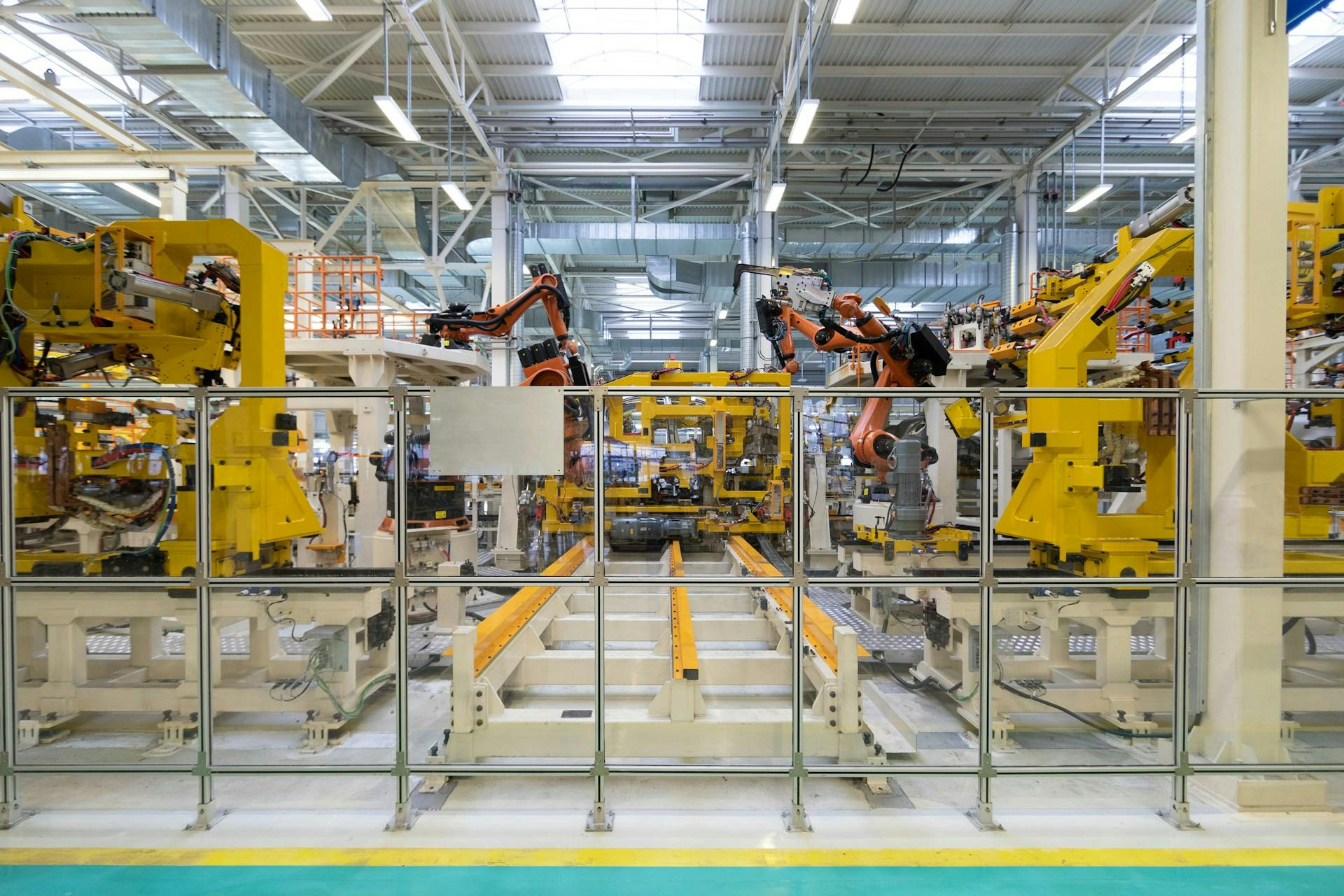How to Improve Manufacturing Productivity: 4 Effective Strategies


Understanding how to increase productivity in manufacturing is essential for industry leaders who want to improve efficiency. Enhancing employee engagement and optimizing communication can significantly impact performance. By adopting effective strategies like lean manufacturing principles and advanced technology solutions, you can enhance your manufacturing operations. Whether you're streamlining workflows or implementing new technologies, these methods can help you remain competitive in the manufacturing industry.
1. Implement Lean Manufacturing Principles
Adopting lean principles in manufacturing helps reduce waste and improve efficiency.
Use Lean Manufacturing to Reduce Waste
Lean manufacturing focuses on minimizing waste while maximizing value. Techniques like Value Stream Mapping help manufacturers visualize and eliminate activities that don't contribute to the final product. Just-in-Time (JIT) production reduces inventory levels, lowering storage costs and minimizing excess. Kanban systems signal when new stock is needed, effectively synchronizing supply with demand. These strategies help reduce waste and maintain a smooth production flow, as highlighted by Lean Production.
Boost Efficiency Using Lean Practices
Implementing the 5S methodology—Sort, Set in Order, Shine, Standardize, and Sustain—organizes the workspace, supporting productivity and safety. Regular assessments of workflows using techniques like Kaizen encourage continuous improvement through small changes. Engaging employees in identifying inefficiencies and suggesting improvements can lead to innovative solutions and a more motivated workforce. Integrating technology, such as Manufacturing Execution Systems, supports these lean practices by providing data for informed decisions, as discussed by Unleashed Software.
By embracing lean manufacturing principles, you reduce unnecessary operations and empower your team to achieve higher productivity.
2. Optimize Workflows and Processes
Optimizing workflows and processes is key to maintaining efficiency and increasing productivity in manufacturing.
Streamline Processes with Effective Methods
To optimize workflows, start by analyzing your current processes thoroughly. Evaluating every step involved—from concept to customer—allows you to identify bottlenecks and inefficiencies. Once these areas are identified, you can make adjustments to streamline operations. Techniques like value stream mapping are effective in visualizing and improving workflows. Implementing lean manufacturing principles helps eliminate waste and ensures processes are efficient. Maintaining low inventory levels and organizing workspaces can enhance productivity and employee satisfaction.
Use Technology to Optimize Processes
Using the right technology can greatly improve your processes. Implementing tools like Enterprise Resource Planning (ERP) software can automate repetitive tasks and provide real-time analytics to monitor production efficiency. Technologies such as IoT and machine learning can automate tasks and provide insights that guide strategic decision-making, optimizing workflows and reducing bottlenecks. By adopting modern technologies, manufacturers can enhance communication, streamline operations, and ensure a seamless flow of information across departments.
Streamlining workflows and incorporating technology into your processes are important steps toward achieving greater productivity in manufacturing. By focusing on these areas, you can create a more efficient and agile manufacturing operation.
3. Improve Employee Productivity and Engagement
Boosting employee productivity and engagement is essential for staying competitive in manufacturing.
Implement Strategies to Increase Employee Productivity
Investing in your workforce's skills is crucial. Regular upskilling and training, including IT in manufacturing training, enhance skills and reduce errors, leading to a more efficient production line. Corning Data notes that a 10% increase in workforce education can yield an 8.6% productivity boost. Maintaining an optimal work environment is also important. Ensuring good lighting and an efficient workspace layout can enhance employee comfort and efficiency, as suggested by Peoplelink Staffing.
Using technology like digital communication tools can streamline tasks and improve workflow, eliminating unnecessary steps and enhancing productivity.
Enhance Employee Engagement to Boost Productivity
Employee engagement greatly influences productivity. Encouraging a collaborative problem-solving culture allows employees to contribute ideas, making them feel valued and invested in the company's success, as highlighted by Corning Data. Implementing effective onboarding strategies, such as the 5 C's of onboarding, helps new employees integrate quickly and feel part of the team. Conducting regular employee engagement surveys can provide insights into employee satisfaction and areas for improvement. Effective communication systems are essential for keeping everyone aligned and motivated, according to the TWI Institute. Recognizing and rewarding employee achievements further enhances morale and productivity.
By integrating these strategies, you can create a work environment that boosts productivity and fosters genuine employee engagement, ensuring long-term success for your manufacturing operation.
4. Use Technology and Automation
Applying technology and automation is crucial for staying competitive in manufacturing.
Implement Technologies to Enhance Productivity
Implementing technologies like Manufacturing Execution Systems (MES) and the Industrial Internet of Things (IIoT) can transform how you handle production data. They allow for real-time data collection and tracking, enabling better decision-making and streamlined processes. AI and machine learning provide insights for optimizing workflows and predicting maintenance needs. Embracing advancements such as AI in workweek transformation can lead to more efficient scheduling and employee satisfaction. Utilizing Enterprise Resource Planning (ERP) software integrates these capabilities, offering a comprehensive solution for managing everything from inventory to employee schedules. Understanding the cost of notification systems is also important when investing in new technologies. By adopting these technologies, your manufacturing processes become faster, more accurate, and efficient.
Increase Efficiency with Automation
Automation significantly improves manufacturing efficiency. By automating repetitive tasks, employees can focus on more critical areas. AI-driven automation allows for predictive maintenance, minimizing downtime and extending machinery lifespan. This proactive approach reduces inefficiencies and ensures production lines run smoothly. As a result, you can achieve higher output with fewer resources, directly impacting your bottom line.
Improve Communication and Collaboration Using Technology
Effective communication is essential in manufacturing operations. Technologies like SMS-based communication systems and ERP software improve communication by providing real-time updates and facilitating seamless coordination. Understanding the advantages of text communication and the benefits of mass texting can enhance your internal communications. Utilizing SMS for employee communication ensures that every team member, from management to frontline workers, is informed. Enhanced communication tools also foster collaboration, enabling teams to work together effectively to solve problems and innovate. By investing in these technologies, you create a more connected and cohesive workforce, ultimately driving productivity and success.
By focusing on these technological advancements, you position your manufacturing operations for greater efficiency and productivity, ensuring long-term success in a competitive market.
Enhance Communication and Collaboration

Effective communication plays a key role in productivity in the manufacturing sector. It ensures that every team member is aligned with the company's goals and can contribute to overcoming challenges. Implementing robust communication systems, such as SMS-based platforms, bridges the gap between management and non-desk employees, facilitating instant information flow and feedback collection. Addressing non-desk communication challenges is essential for maintaining productivity. According to Corning Data, these systems allow for real-time updates and ensure that no employee is left uninformed, which is essential for maintaining productivity and engagement.
Digital communication platforms are invaluable in enhancing workplace communication. They offer seamless coordination across production lines and supply chains, enhancing visibility and reducing errors, as noted by PTC. Considering the texting vs email advantages helps in choosing the most effective communication methods. By leveraging these platforms, manufacturers can ensure that all employees, regardless of their location or role, have access to the information they need to perform their tasks efficiently. Exploring communication apps for non-desk workers can further enhance connectivity.
Incorporating these communication strategies not only improves operational efficiency but also strengthens employee engagement, making your manufacturing operations more resilient and productive. Following internal communications best practices can further optimize the flow of information within your organization.
Empower Your Workforce for Maximum Productivity
Implementing strategies for improving productivity is essential in today's manufacturing landscape. By focusing on lean principles, optimizing workflows, engaging employees, and using the latest technologies, you can achieve significant efficiency gains.
Effective communication enhances these strategies. That's where Yourco comes in. Yourco's SMS-based employee app is designed for the non-desk workforce, bridging the communication gap between management and frontline workers. With instant, direct communication, you can keep your entire team informed, engaged, and aligned with your company's goals.
Yourco provides a reliable and straightforward platform that enhances transparency and fosters a collaborative environment. By enabling real-time updates and feedback, Yourco helps you streamline operations, reduce errors, and boost overall productivity. Don't let outdated communication methods hold your manufacturing operations back.
Try Yourco for free today or schedule a demo and see the difference the right workplace communication solution can make in your company.


